TAXATION Assignment - Finance, Semester 1, University Name
VerifiedAdded on 2020/02/24
|12
|2531
|107
Homework Assignment
AI Summary
This TAXATION assignment solution addresses various aspects of Australian taxation, including fringe benefits tax, assessable income, and allowable deductions. It examines scenarios like flight reward points, compensation for damaged capital assets, gifts, and gains for sportspeople, providing insights into their tax implications. The assignment also covers employee reimbursements, deductions for art-related expenses, and travel expenses. Furthermore, it analyzes a case study involving a student's tax liability, calculating assessable income and tax payable, while considering self-education expenses, and work-related deductions for computers, printers and mobile phones. The solution uses relevant Australian Taxation Office rulings and case laws to support its analysis, providing a comprehensive understanding of taxation principles and their application in diverse situations.
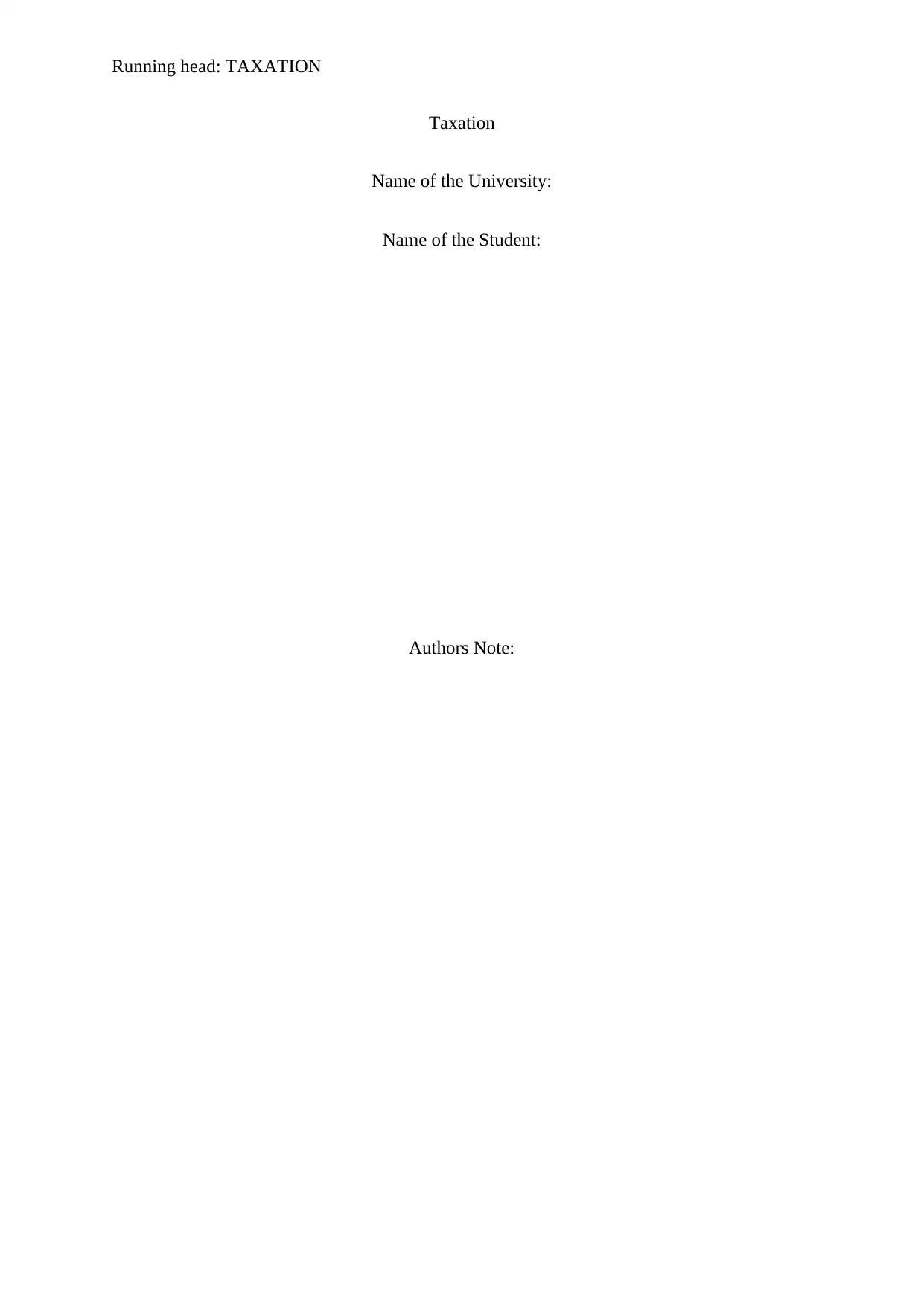
Running head: TAXATION
Taxation
Name of the University:
Name of the Student:
Authors Note:
Taxation
Name of the University:
Name of the Student:
Authors Note:
Paraphrase This Document
Need a fresh take? Get an instant paraphrase of this document with our AI Paraphraser
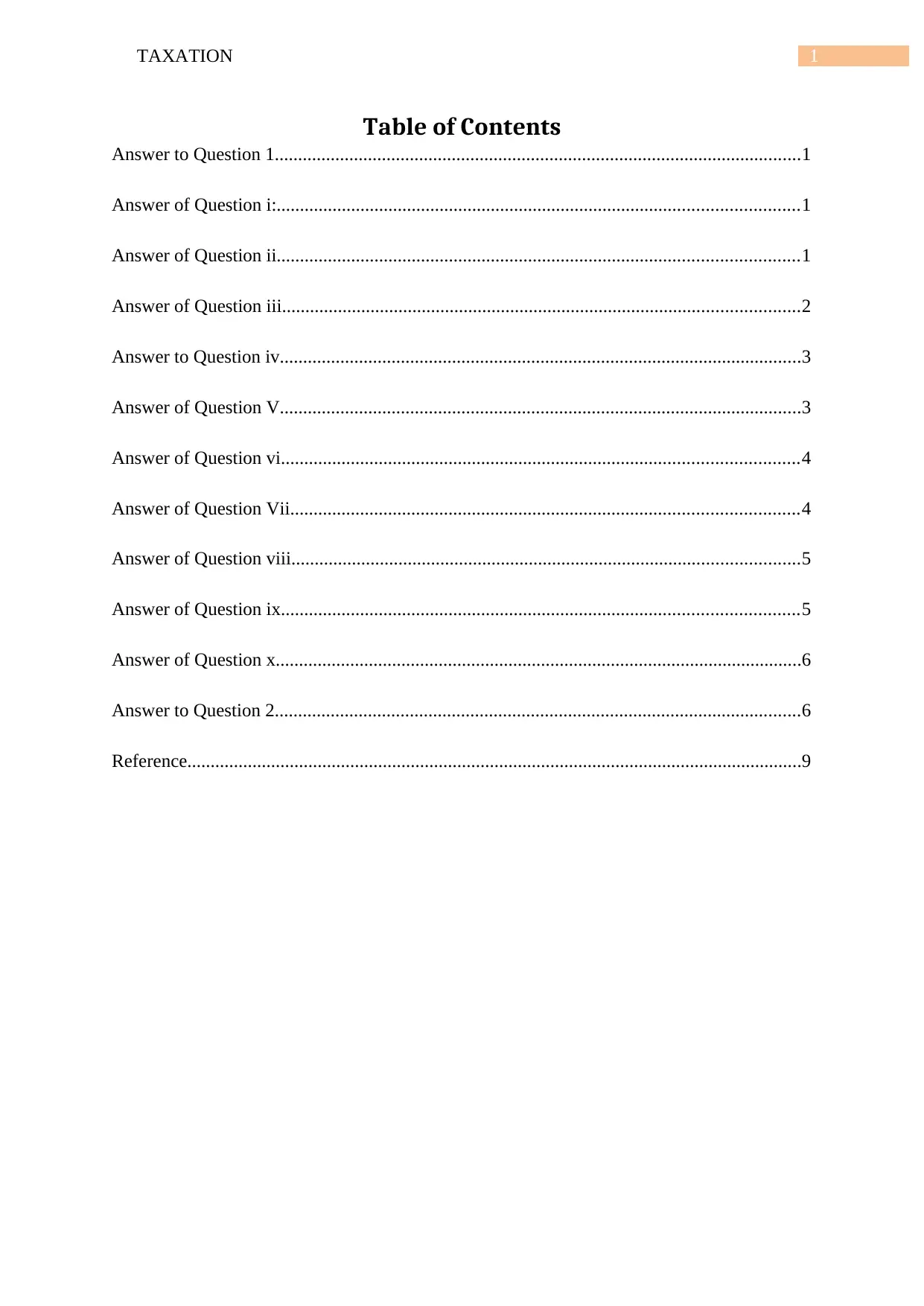
1TAXATION
Table of Contents
Answer to Question 1.................................................................................................................1
Answer of Question i:................................................................................................................1
Answer of Question ii................................................................................................................1
Answer of Question iii...............................................................................................................2
Answer to Question iv................................................................................................................3
Answer of Question V................................................................................................................3
Answer of Question vi...............................................................................................................4
Answer of Question Vii.............................................................................................................4
Answer of Question viii.............................................................................................................5
Answer of Question ix...............................................................................................................5
Answer of Question x.................................................................................................................6
Answer to Question 2.................................................................................................................6
Reference....................................................................................................................................9
Table of Contents
Answer to Question 1.................................................................................................................1
Answer of Question i:................................................................................................................1
Answer of Question ii................................................................................................................1
Answer of Question iii...............................................................................................................2
Answer to Question iv................................................................................................................3
Answer of Question V................................................................................................................3
Answer of Question vi...............................................................................................................4
Answer of Question Vii.............................................................................................................4
Answer of Question viii.............................................................................................................5
Answer of Question ix...............................................................................................................5
Answer of Question x.................................................................................................................6
Answer to Question 2.................................................................................................................6
Reference....................................................................................................................................9
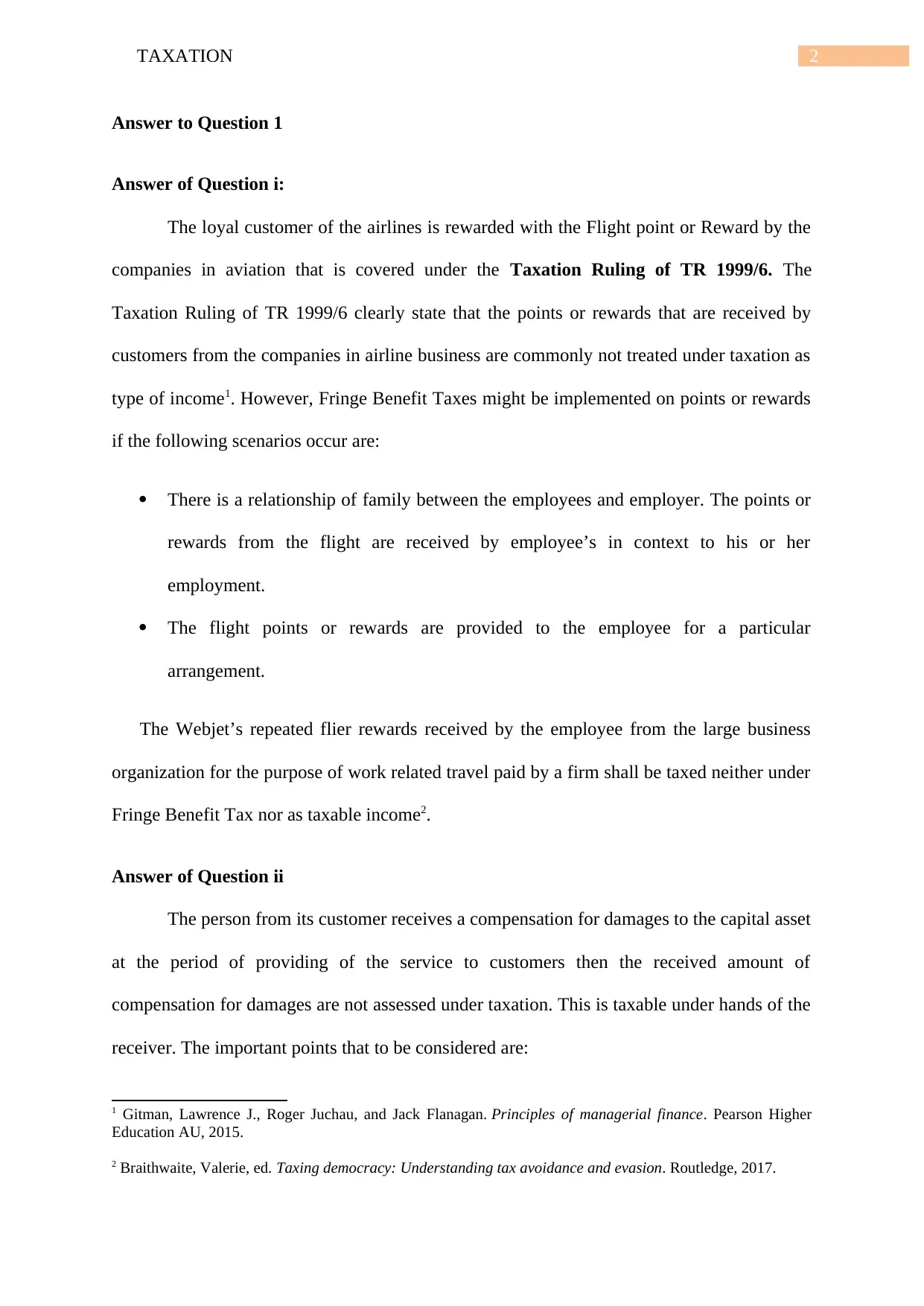
2TAXATION
Answer to Question 1
Answer of Question i:
The loyal customer of the airlines is rewarded with the Flight point or Reward by the
companies in aviation that is covered under the Taxation Ruling of TR 1999/6. The
Taxation Ruling of TR 1999/6 clearly state that the points or rewards that are received by
customers from the companies in airline business are commonly not treated under taxation as
type of income1. However, Fringe Benefit Taxes might be implemented on points or rewards
if the following scenarios occur are:
There is a relationship of family between the employees and employer. The points or
rewards from the flight are received by employee’s in context to his or her
employment.
The flight points or rewards are provided to the employee for a particular
arrangement.
The Webjet’s repeated flier rewards received by the employee from the large business
organization for the purpose of work related travel paid by a firm shall be taxed neither under
Fringe Benefit Tax nor as taxable income2.
Answer of Question ii
The person from its customer receives a compensation for damages to the capital asset
at the period of providing of the service to customers then the received amount of
compensation for damages are not assessed under taxation. This is taxable under hands of the
receiver. The important points that to be considered are:
1 Gitman, Lawrence J., Roger Juchau, and Jack Flanagan. Principles of managerial finance. Pearson Higher
Education AU, 2015.
2 Braithwaite, Valerie, ed. Taxing democracy: Understanding tax avoidance and evasion. Routledge, 2017.
Answer to Question 1
Answer of Question i:
The loyal customer of the airlines is rewarded with the Flight point or Reward by the
companies in aviation that is covered under the Taxation Ruling of TR 1999/6. The
Taxation Ruling of TR 1999/6 clearly state that the points or rewards that are received by
customers from the companies in airline business are commonly not treated under taxation as
type of income1. However, Fringe Benefit Taxes might be implemented on points or rewards
if the following scenarios occur are:
There is a relationship of family between the employees and employer. The points or
rewards from the flight are received by employee’s in context to his or her
employment.
The flight points or rewards are provided to the employee for a particular
arrangement.
The Webjet’s repeated flier rewards received by the employee from the large business
organization for the purpose of work related travel paid by a firm shall be taxed neither under
Fringe Benefit Tax nor as taxable income2.
Answer of Question ii
The person from its customer receives a compensation for damages to the capital asset
at the period of providing of the service to customers then the received amount of
compensation for damages are not assessed under taxation. This is taxable under hands of the
receiver. The important points that to be considered are:
1 Gitman, Lawrence J., Roger Juchau, and Jack Flanagan. Principles of managerial finance. Pearson Higher
Education AU, 2015.
2 Braithwaite, Valerie, ed. Taxing democracy: Understanding tax avoidance and evasion. Routledge, 2017.
⊘ This is a preview!⊘
Do you want full access?
Subscribe today to unlock all pages.

Trusted by 1+ million students worldwide
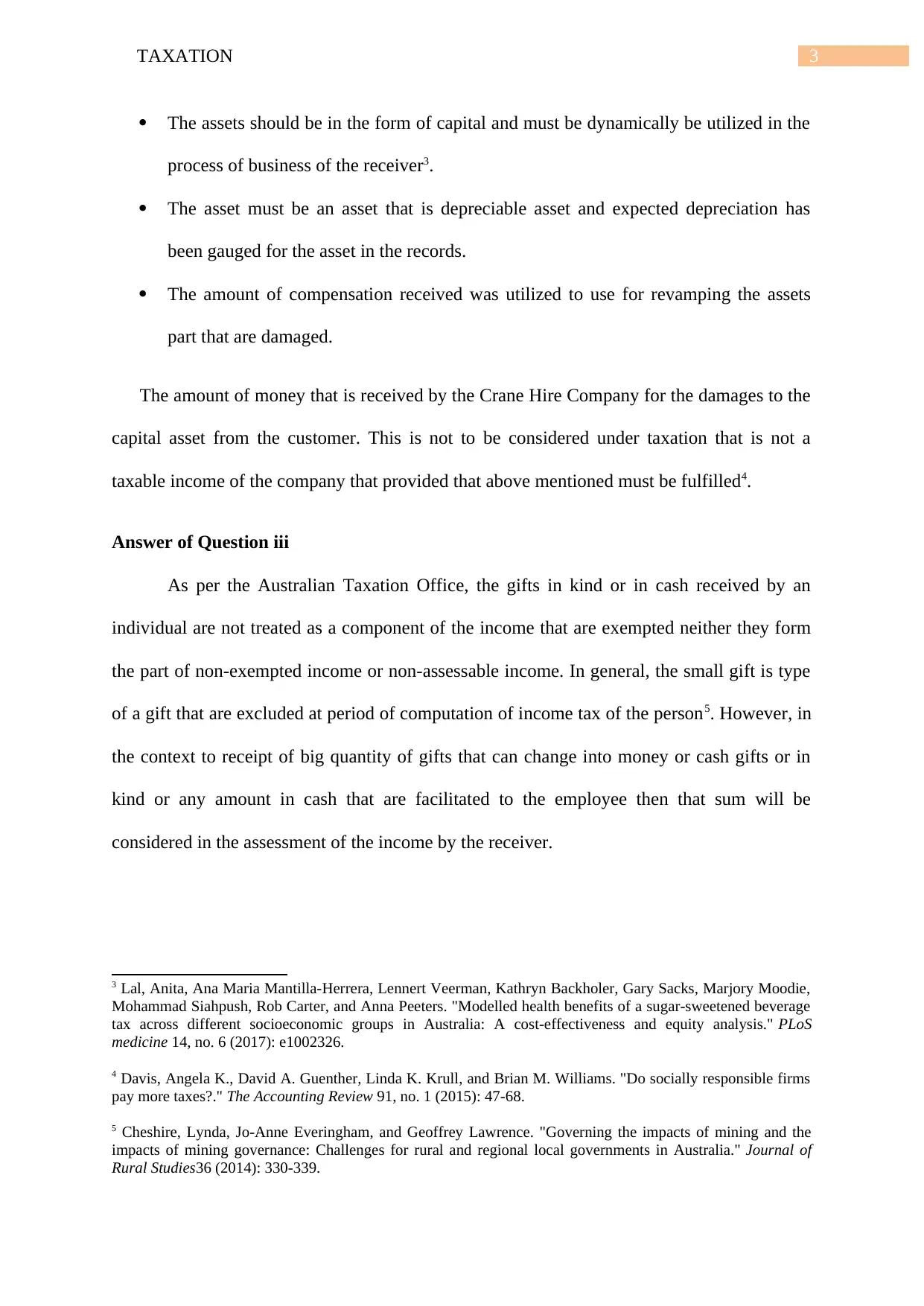
3TAXATION
The assets should be in the form of capital and must be dynamically be utilized in the
process of business of the receiver3.
The asset must be an asset that is depreciable asset and expected depreciation has
been gauged for the asset in the records.
The amount of compensation received was utilized to use for revamping the assets
part that are damaged.
The amount of money that is received by the Crane Hire Company for the damages to the
capital asset from the customer. This is not to be considered under taxation that is not a
taxable income of the company that provided that above mentioned must be fulfilled4.
Answer of Question iii
As per the Australian Taxation Office, the gifts in kind or in cash received by an
individual are not treated as a component of the income that are exempted neither they form
the part of non-exempted income or non-assessable income. In general, the small gift is type
of a gift that are excluded at period of computation of income tax of the person5. However, in
the context to receipt of big quantity of gifts that can change into money or cash gifts or in
kind or any amount in cash that are facilitated to the employee then that sum will be
considered in the assessment of the income by the receiver.
3 Lal, Anita, Ana Maria Mantilla-Herrera, Lennert Veerman, Kathryn Backholer, Gary Sacks, Marjory Moodie,
Mohammad Siahpush, Rob Carter, and Anna Peeters. "Modelled health benefits of a sugar-sweetened beverage
tax across different socioeconomic groups in Australia: A cost-effectiveness and equity analysis." PLoS
medicine 14, no. 6 (2017): e1002326.
4 Davis, Angela K., David A. Guenther, Linda K. Krull, and Brian M. Williams. "Do socially responsible firms
pay more taxes?." The Accounting Review 91, no. 1 (2015): 47-68.
5 Cheshire, Lynda, Jo-Anne Everingham, and Geoffrey Lawrence. "Governing the impacts of mining and the
impacts of mining governance: Challenges for rural and regional local governments in Australia." Journal of
Rural Studies36 (2014): 330-339.
The assets should be in the form of capital and must be dynamically be utilized in the
process of business of the receiver3.
The asset must be an asset that is depreciable asset and expected depreciation has
been gauged for the asset in the records.
The amount of compensation received was utilized to use for revamping the assets
part that are damaged.
The amount of money that is received by the Crane Hire Company for the damages to the
capital asset from the customer. This is not to be considered under taxation that is not a
taxable income of the company that provided that above mentioned must be fulfilled4.
Answer of Question iii
As per the Australian Taxation Office, the gifts in kind or in cash received by an
individual are not treated as a component of the income that are exempted neither they form
the part of non-exempted income or non-assessable income. In general, the small gift is type
of a gift that are excluded at period of computation of income tax of the person5. However, in
the context to receipt of big quantity of gifts that can change into money or cash gifts or in
kind or any amount in cash that are facilitated to the employee then that sum will be
considered in the assessment of the income by the receiver.
3 Lal, Anita, Ana Maria Mantilla-Herrera, Lennert Veerman, Kathryn Backholer, Gary Sacks, Marjory Moodie,
Mohammad Siahpush, Rob Carter, and Anna Peeters. "Modelled health benefits of a sugar-sweetened beverage
tax across different socioeconomic groups in Australia: A cost-effectiveness and equity analysis." PLoS
medicine 14, no. 6 (2017): e1002326.
4 Davis, Angela K., David A. Guenther, Linda K. Krull, and Brian M. Williams. "Do socially responsible firms
pay more taxes?." The Accounting Review 91, no. 1 (2015): 47-68.
5 Cheshire, Lynda, Jo-Anne Everingham, and Geoffrey Lawrence. "Governing the impacts of mining and the
impacts of mining governance: Challenges for rural and regional local governments in Australia." Journal of
Rural Studies36 (2014): 330-339.
Paraphrase This Document
Need a fresh take? Get an instant paraphrase of this document with our AI Paraphraser
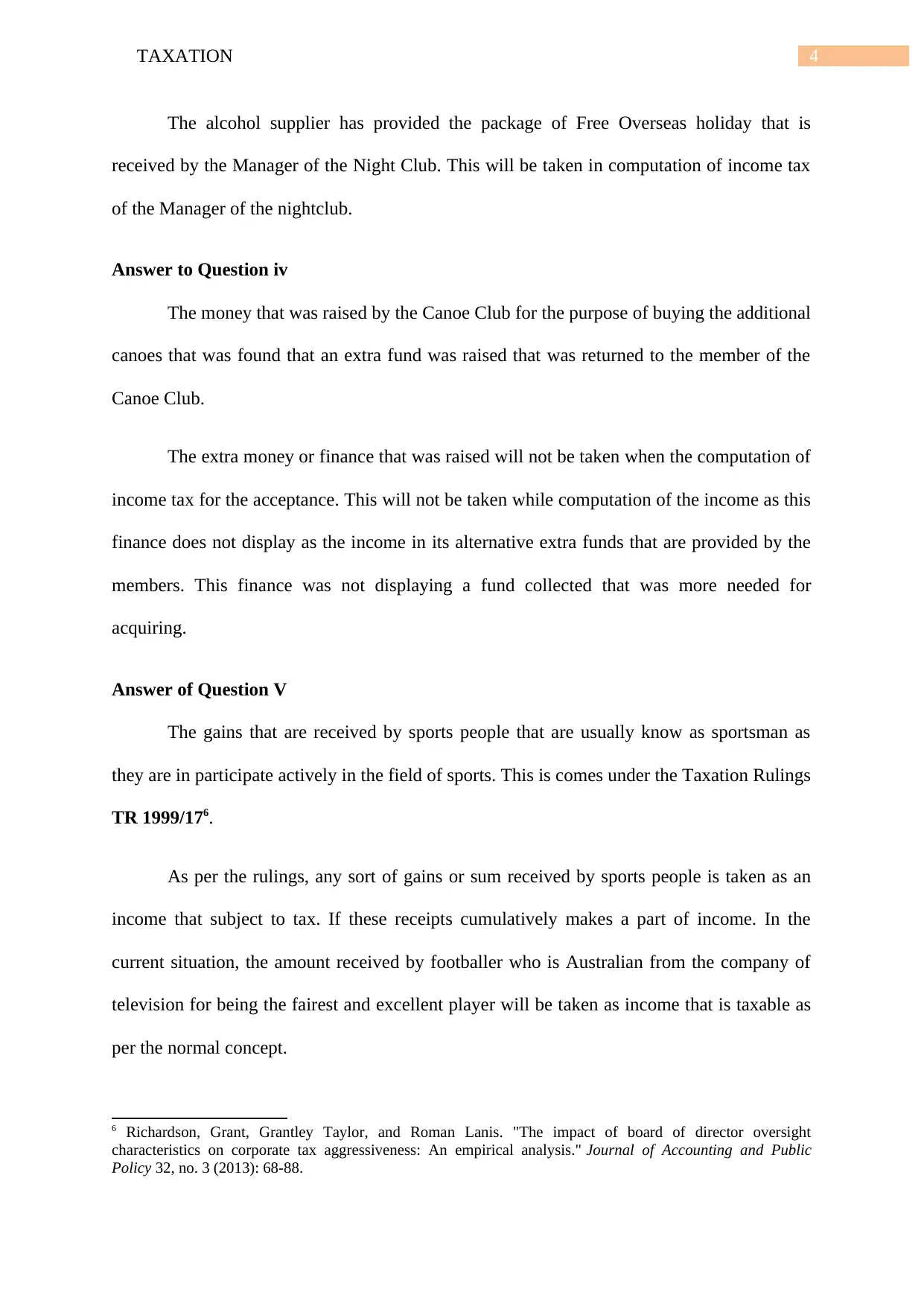
4TAXATION
The alcohol supplier has provided the package of Free Overseas holiday that is
received by the Manager of the Night Club. This will be taken in computation of income tax
of the Manager of the nightclub.
Answer to Question iv
The money that was raised by the Canoe Club for the purpose of buying the additional
canoes that was found that an extra fund was raised that was returned to the member of the
Canoe Club.
The extra money or finance that was raised will not be taken when the computation of
income tax for the acceptance. This will not be taken while computation of the income as this
finance does not display as the income in its alternative extra funds that are provided by the
members. This finance was not displaying a fund collected that was more needed for
acquiring.
Answer of Question V
The gains that are received by sports people that are usually know as sportsman as
they are in participate actively in the field of sports. This is comes under the Taxation Rulings
TR 1999/176.
As per the rulings, any sort of gains or sum received by sports people is taken as an
income that subject to tax. If these receipts cumulatively makes a part of income. In the
current situation, the amount received by footballer who is Australian from the company of
television for being the fairest and excellent player will be taken as income that is taxable as
per the normal concept.
6 Richardson, Grant, Grantley Taylor, and Roman Lanis. "The impact of board of director oversight
characteristics on corporate tax aggressiveness: An empirical analysis." Journal of Accounting and Public
Policy 32, no. 3 (2013): 68-88.
The alcohol supplier has provided the package of Free Overseas holiday that is
received by the Manager of the Night Club. This will be taken in computation of income tax
of the Manager of the nightclub.
Answer to Question iv
The money that was raised by the Canoe Club for the purpose of buying the additional
canoes that was found that an extra fund was raised that was returned to the member of the
Canoe Club.
The extra money or finance that was raised will not be taken when the computation of
income tax for the acceptance. This will not be taken while computation of the income as this
finance does not display as the income in its alternative extra funds that are provided by the
members. This finance was not displaying a fund collected that was more needed for
acquiring.
Answer of Question V
The gains that are received by sports people that are usually know as sportsman as
they are in participate actively in the field of sports. This is comes under the Taxation Rulings
TR 1999/176.
As per the rulings, any sort of gains or sum received by sports people is taken as an
income that subject to tax. If these receipts cumulatively makes a part of income. In the
current situation, the amount received by footballer who is Australian from the company of
television for being the fairest and excellent player will be taken as income that is taxable as
per the normal concept.
6 Richardson, Grant, Grantley Taylor, and Roman Lanis. "The impact of board of director oversight
characteristics on corporate tax aggressiveness: An empirical analysis." Journal of Accounting and Public
Policy 32, no. 3 (2013): 68-88.
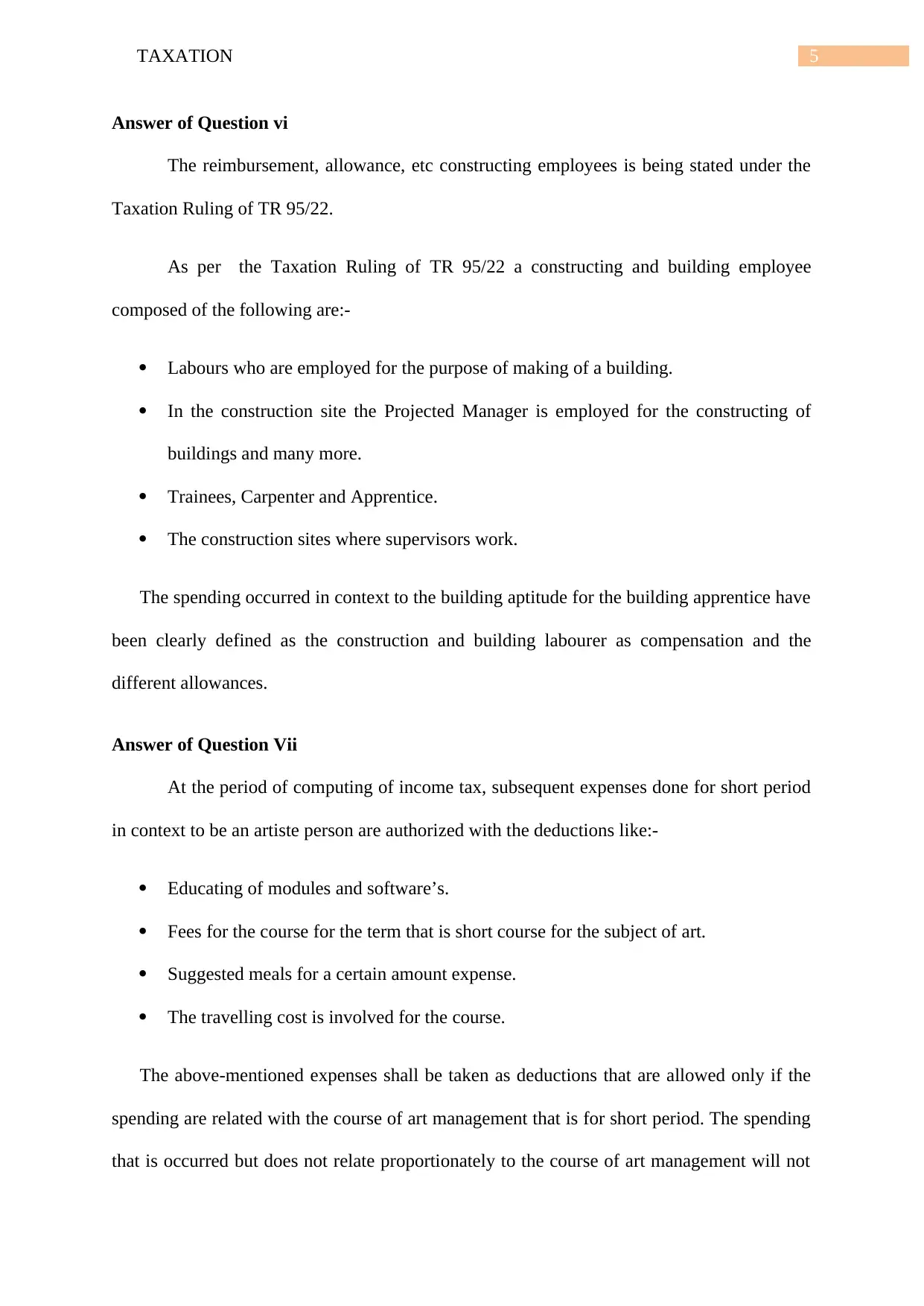
5TAXATION
Answer of Question vi
The reimbursement, allowance, etc constructing employees is being stated under the
Taxation Ruling of TR 95/22.
As per the Taxation Ruling of TR 95/22 a constructing and building employee
composed of the following are:-
Labours who are employed for the purpose of making of a building.
In the construction site the Projected Manager is employed for the constructing of
buildings and many more.
Trainees, Carpenter and Apprentice.
The construction sites where supervisors work.
The spending occurred in context to the building aptitude for the building apprentice have
been clearly defined as the construction and building labourer as compensation and the
different allowances.
Answer of Question Vii
At the period of computing of income tax, subsequent expenses done for short period
in context to be an artiste person are authorized with the deductions like:-
Educating of modules and software’s.
Fees for the course for the term that is short course for the subject of art.
Suggested meals for a certain amount expense.
The travelling cost is involved for the course.
The above-mentioned expenses shall be taken as deductions that are allowed only if the
spending are related with the course of art management that is for short period. The spending
that is occurred but does not relate proportionately to the course of art management will not
Answer of Question vi
The reimbursement, allowance, etc constructing employees is being stated under the
Taxation Ruling of TR 95/22.
As per the Taxation Ruling of TR 95/22 a constructing and building employee
composed of the following are:-
Labours who are employed for the purpose of making of a building.
In the construction site the Projected Manager is employed for the constructing of
buildings and many more.
Trainees, Carpenter and Apprentice.
The construction sites where supervisors work.
The spending occurred in context to the building aptitude for the building apprentice have
been clearly defined as the construction and building labourer as compensation and the
different allowances.
Answer of Question Vii
At the period of computing of income tax, subsequent expenses done for short period
in context to be an artiste person are authorized with the deductions like:-
Educating of modules and software’s.
Fees for the course for the term that is short course for the subject of art.
Suggested meals for a certain amount expense.
The travelling cost is involved for the course.
The above-mentioned expenses shall be taken as deductions that are allowed only if the
spending are related with the course of art management that is for short period. The spending
that is occurred but does not relate proportionately to the course of art management will not
⊘ This is a preview!⊘
Do you want full access?
Subscribe today to unlock all pages.

Trusted by 1+ million students worldwide
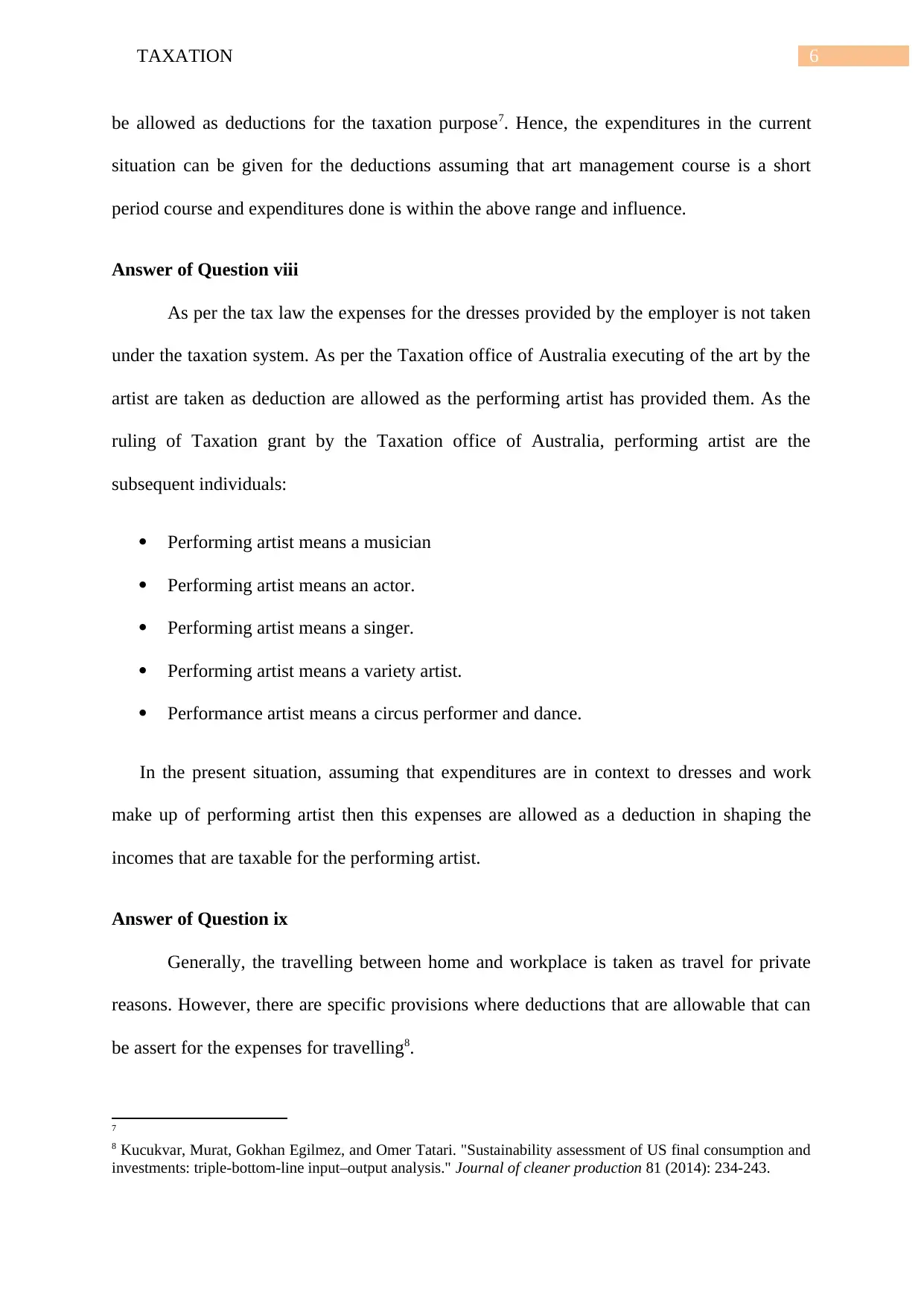
6TAXATION
be allowed as deductions for the taxation purpose7. Hence, the expenditures in the current
situation can be given for the deductions assuming that art management course is a short
period course and expenditures done is within the above range and influence.
Answer of Question viii
As per the tax law the expenses for the dresses provided by the employer is not taken
under the taxation system. As per the Taxation office of Australia executing of the art by the
artist are taken as deduction are allowed as the performing artist has provided them. As the
ruling of Taxation grant by the Taxation office of Australia, performing artist are the
subsequent individuals:
Performing artist means a musician
Performing artist means an actor.
Performing artist means a singer.
Performing artist means a variety artist.
Performance artist means a circus performer and dance.
In the present situation, assuming that expenditures are in context to dresses and work
make up of performing artist then this expenses are allowed as a deduction in shaping the
incomes that are taxable for the performing artist.
Answer of Question ix
Generally, the travelling between home and workplace is taken as travel for private
reasons. However, there are specific provisions where deductions that are allowable that can
be assert for the expenses for travelling8.
7
8 Kucukvar, Murat, Gokhan Egilmez, and Omer Tatari. "Sustainability assessment of US final consumption and
investments: triple-bottom-line input–output analysis." Journal of cleaner production 81 (2014): 234-243.
be allowed as deductions for the taxation purpose7. Hence, the expenditures in the current
situation can be given for the deductions assuming that art management course is a short
period course and expenditures done is within the above range and influence.
Answer of Question viii
As per the tax law the expenses for the dresses provided by the employer is not taken
under the taxation system. As per the Taxation office of Australia executing of the art by the
artist are taken as deduction are allowed as the performing artist has provided them. As the
ruling of Taxation grant by the Taxation office of Australia, performing artist are the
subsequent individuals:
Performing artist means a musician
Performing artist means an actor.
Performing artist means a singer.
Performing artist means a variety artist.
Performance artist means a circus performer and dance.
In the present situation, assuming that expenditures are in context to dresses and work
make up of performing artist then this expenses are allowed as a deduction in shaping the
incomes that are taxable for the performing artist.
Answer of Question ix
Generally, the travelling between home and workplace is taken as travel for private
reasons. However, there are specific provisions where deductions that are allowable that can
be assert for the expenses for travelling8.
7
8 Kucukvar, Murat, Gokhan Egilmez, and Omer Tatari. "Sustainability assessment of US final consumption and
investments: triple-bottom-line input–output analysis." Journal of cleaner production 81 (2014): 234-243.
Paraphrase This Document
Need a fresh take? Get an instant paraphrase of this document with our AI Paraphraser
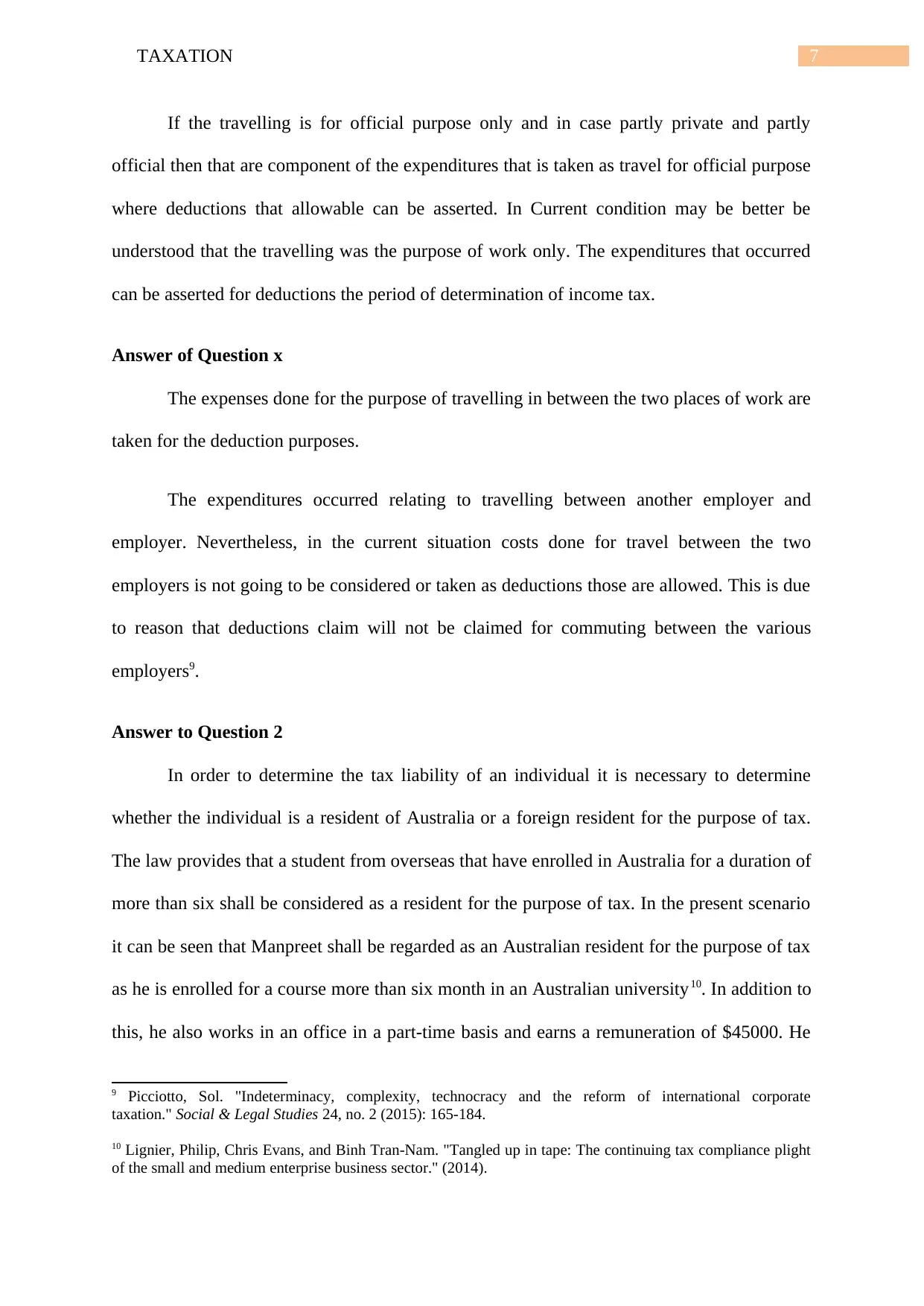
7TAXATION
If the travelling is for official purpose only and in case partly private and partly
official then that are component of the expenditures that is taken as travel for official purpose
where deductions that allowable can be asserted. In Current condition may be better be
understood that the travelling was the purpose of work only. The expenditures that occurred
can be asserted for deductions the period of determination of income tax.
Answer of Question x
The expenses done for the purpose of travelling in between the two places of work are
taken for the deduction purposes.
The expenditures occurred relating to travelling between another employer and
employer. Nevertheless, in the current situation costs done for travel between the two
employers is not going to be considered or taken as deductions those are allowed. This is due
to reason that deductions claim will not be claimed for commuting between the various
employers9.
Answer to Question 2
In order to determine the tax liability of an individual it is necessary to determine
whether the individual is a resident of Australia or a foreign resident for the purpose of tax.
The law provides that a student from overseas that have enrolled in Australia for a duration of
more than six shall be considered as a resident for the purpose of tax. In the present scenario
it can be seen that Manpreet shall be regarded as an Australian resident for the purpose of tax
as he is enrolled for a course more than six month in an Australian university10. In addition to
this, he also works in an office in a part-time basis and earns a remuneration of $45000. He
9 Picciotto, Sol. "Indeterminacy, complexity, technocracy and the reform of international corporate
taxation." Social & Legal Studies 24, no. 2 (2015): 165-184.
10 Lignier, Philip, Chris Evans, and Binh Tran-Nam. "Tangled up in tape: The continuing tax compliance plight
of the small and medium enterprise business sector." (2014).
If the travelling is for official purpose only and in case partly private and partly
official then that are component of the expenditures that is taken as travel for official purpose
where deductions that allowable can be asserted. In Current condition may be better be
understood that the travelling was the purpose of work only. The expenditures that occurred
can be asserted for deductions the period of determination of income tax.
Answer of Question x
The expenses done for the purpose of travelling in between the two places of work are
taken for the deduction purposes.
The expenditures occurred relating to travelling between another employer and
employer. Nevertheless, in the current situation costs done for travel between the two
employers is not going to be considered or taken as deductions those are allowed. This is due
to reason that deductions claim will not be claimed for commuting between the various
employers9.
Answer to Question 2
In order to determine the tax liability of an individual it is necessary to determine
whether the individual is a resident of Australia or a foreign resident for the purpose of tax.
The law provides that a student from overseas that have enrolled in Australia for a duration of
more than six shall be considered as a resident for the purpose of tax. In the present scenario
it can be seen that Manpreet shall be regarded as an Australian resident for the purpose of tax
as he is enrolled for a course more than six month in an Australian university10. In addition to
this, he also works in an office in a part-time basis and earns a remuneration of $45000. He
9 Picciotto, Sol. "Indeterminacy, complexity, technocracy and the reform of international corporate
taxation." Social & Legal Studies 24, no. 2 (2015): 165-184.
10 Lignier, Philip, Chris Evans, and Binh Tran-Nam. "Tangled up in tape: The continuing tax compliance plight
of the small and medium enterprise business sector." (2014).
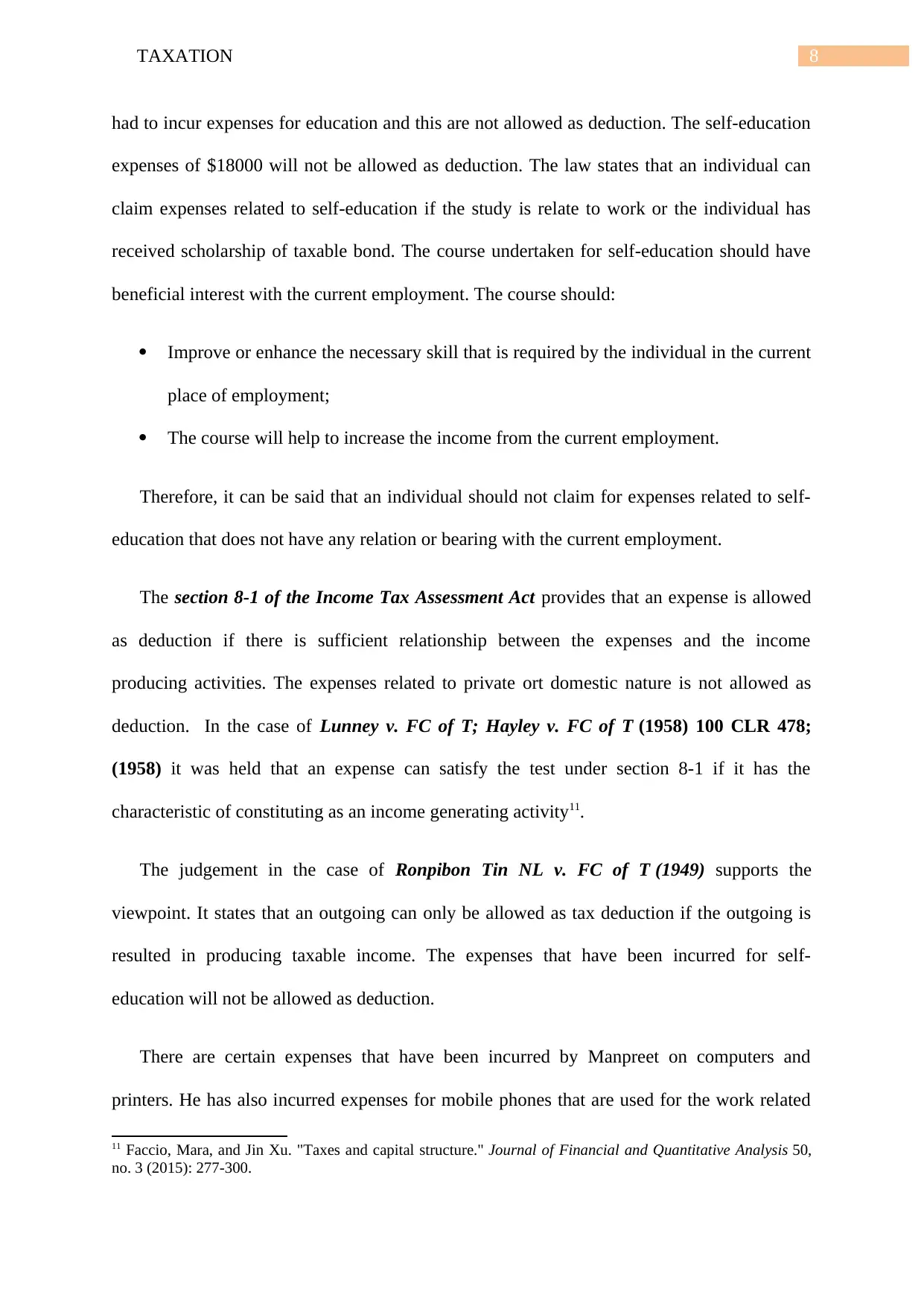
8TAXATION
had to incur expenses for education and this are not allowed as deduction. The self-education
expenses of $18000 will not be allowed as deduction. The law states that an individual can
claim expenses related to self-education if the study is relate to work or the individual has
received scholarship of taxable bond. The course undertaken for self-education should have
beneficial interest with the current employment. The course should:
Improve or enhance the necessary skill that is required by the individual in the current
place of employment;
The course will help to increase the income from the current employment.
Therefore, it can be said that an individual should not claim for expenses related to self-
education that does not have any relation or bearing with the current employment.
The section 8-1 of the Income Tax Assessment Act provides that an expense is allowed
as deduction if there is sufficient relationship between the expenses and the income
producing activities. The expenses related to private ort domestic nature is not allowed as
deduction. In the case of Lunney v. FC of T; Hayley v. FC of T (1958) 100 CLR 478;
(1958) it was held that an expense can satisfy the test under section 8-1 if it has the
characteristic of constituting as an income generating activity11.
The judgement in the case of Ronpibon Tin NL v. FC of T (1949) supports the
viewpoint. It states that an outgoing can only be allowed as tax deduction if the outgoing is
resulted in producing taxable income. The expenses that have been incurred for self-
education will not be allowed as deduction.
There are certain expenses that have been incurred by Manpreet on computers and
printers. He has also incurred expenses for mobile phones that are used for the work related
11 Faccio, Mara, and Jin Xu. "Taxes and capital structure." Journal of Financial and Quantitative Analysis 50,
no. 3 (2015): 277-300.
had to incur expenses for education and this are not allowed as deduction. The self-education
expenses of $18000 will not be allowed as deduction. The law states that an individual can
claim expenses related to self-education if the study is relate to work or the individual has
received scholarship of taxable bond. The course undertaken for self-education should have
beneficial interest with the current employment. The course should:
Improve or enhance the necessary skill that is required by the individual in the current
place of employment;
The course will help to increase the income from the current employment.
Therefore, it can be said that an individual should not claim for expenses related to self-
education that does not have any relation or bearing with the current employment.
The section 8-1 of the Income Tax Assessment Act provides that an expense is allowed
as deduction if there is sufficient relationship between the expenses and the income
producing activities. The expenses related to private ort domestic nature is not allowed as
deduction. In the case of Lunney v. FC of T; Hayley v. FC of T (1958) 100 CLR 478;
(1958) it was held that an expense can satisfy the test under section 8-1 if it has the
characteristic of constituting as an income generating activity11.
The judgement in the case of Ronpibon Tin NL v. FC of T (1949) supports the
viewpoint. It states that an outgoing can only be allowed as tax deduction if the outgoing is
resulted in producing taxable income. The expenses that have been incurred for self-
education will not be allowed as deduction.
There are certain expenses that have been incurred by Manpreet on computers and
printers. He has also incurred expenses for mobile phones that are used for the work related
11 Faccio, Mara, and Jin Xu. "Taxes and capital structure." Journal of Financial and Quantitative Analysis 50,
no. 3 (2015): 277-300.
⊘ This is a preview!⊘
Do you want full access?
Subscribe today to unlock all pages.

Trusted by 1+ million students worldwide
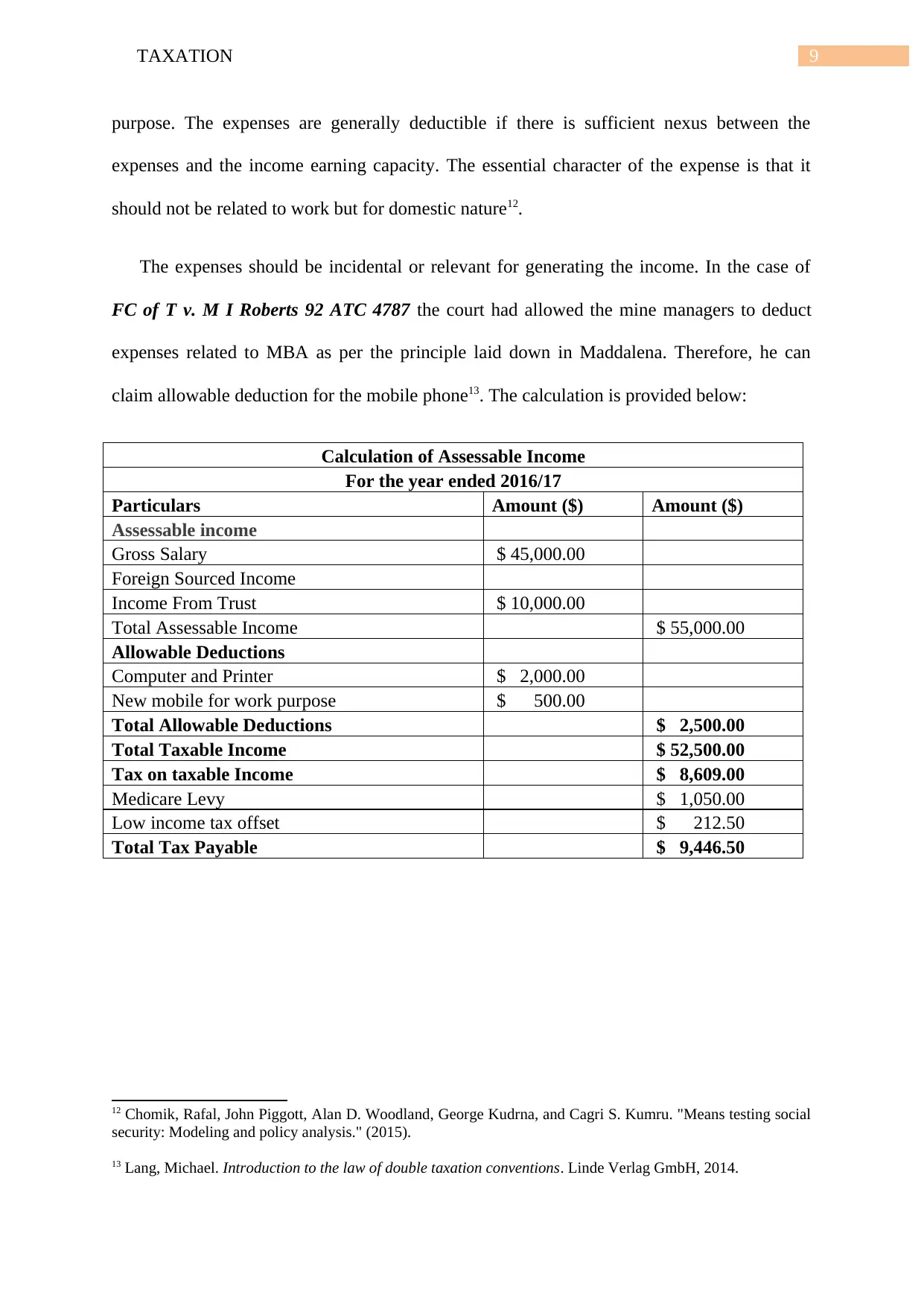
9TAXATION
purpose. The expenses are generally deductible if there is sufficient nexus between the
expenses and the income earning capacity. The essential character of the expense is that it
should not be related to work but for domestic nature12.
The expenses should be incidental or relevant for generating the income. In the case of
FC of T v. M I Roberts 92 ATC 4787 the court had allowed the mine managers to deduct
expenses related to MBA as per the principle laid down in Maddalena. Therefore, he can
claim allowable deduction for the mobile phone13. The calculation is provided below:
Calculation of Assessable Income
For the year ended 2016/17
Particulars Amount ($) Amount ($)
Assessable income
Gross Salary $ 45,000.00
Foreign Sourced Income
Income From Trust $ 10,000.00
Total Assessable Income $ 55,000.00
Allowable Deductions
Computer and Printer $ 2,000.00
New mobile for work purpose $ 500.00
Total Allowable Deductions $ 2,500.00
Total Taxable Income $ 52,500.00
Tax on taxable Income $ 8,609.00
Medicare Levy $ 1,050.00
Low income tax offset $ 212.50
Total Tax Payable $ 9,446.50
12 Chomik, Rafal, John Piggott, Alan D. Woodland, George Kudrna, and Cagri S. Kumru. "Means testing social
security: Modeling and policy analysis." (2015).
13 Lang, Michael. Introduction to the law of double taxation conventions. Linde Verlag GmbH, 2014.
purpose. The expenses are generally deductible if there is sufficient nexus between the
expenses and the income earning capacity. The essential character of the expense is that it
should not be related to work but for domestic nature12.
The expenses should be incidental or relevant for generating the income. In the case of
FC of T v. M I Roberts 92 ATC 4787 the court had allowed the mine managers to deduct
expenses related to MBA as per the principle laid down in Maddalena. Therefore, he can
claim allowable deduction for the mobile phone13. The calculation is provided below:
Calculation of Assessable Income
For the year ended 2016/17
Particulars Amount ($) Amount ($)
Assessable income
Gross Salary $ 45,000.00
Foreign Sourced Income
Income From Trust $ 10,000.00
Total Assessable Income $ 55,000.00
Allowable Deductions
Computer and Printer $ 2,000.00
New mobile for work purpose $ 500.00
Total Allowable Deductions $ 2,500.00
Total Taxable Income $ 52,500.00
Tax on taxable Income $ 8,609.00
Medicare Levy $ 1,050.00
Low income tax offset $ 212.50
Total Tax Payable $ 9,446.50
12 Chomik, Rafal, John Piggott, Alan D. Woodland, George Kudrna, and Cagri S. Kumru. "Means testing social
security: Modeling and policy analysis." (2015).
13 Lang, Michael. Introduction to the law of double taxation conventions. Linde Verlag GmbH, 2014.
Paraphrase This Document
Need a fresh take? Get an instant paraphrase of this document with our AI Paraphraser
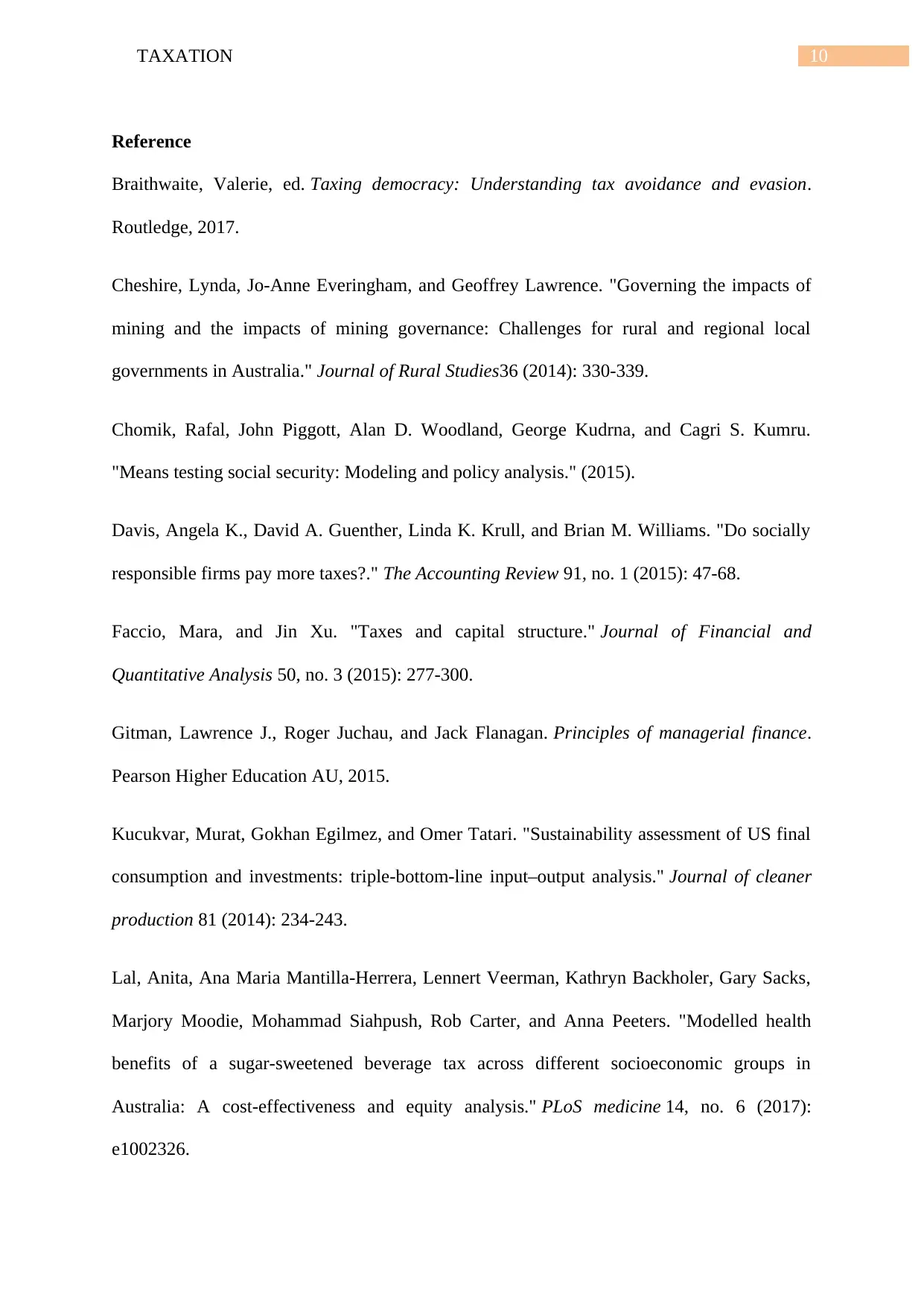
10TAXATION
Reference
Braithwaite, Valerie, ed. Taxing democracy: Understanding tax avoidance and evasion.
Routledge, 2017.
Cheshire, Lynda, Jo-Anne Everingham, and Geoffrey Lawrence. "Governing the impacts of
mining and the impacts of mining governance: Challenges for rural and regional local
governments in Australia." Journal of Rural Studies36 (2014): 330-339.
Chomik, Rafal, John Piggott, Alan D. Woodland, George Kudrna, and Cagri S. Kumru.
"Means testing social security: Modeling and policy analysis." (2015).
Davis, Angela K., David A. Guenther, Linda K. Krull, and Brian M. Williams. "Do socially
responsible firms pay more taxes?." The Accounting Review 91, no. 1 (2015): 47-68.
Faccio, Mara, and Jin Xu. "Taxes and capital structure." Journal of Financial and
Quantitative Analysis 50, no. 3 (2015): 277-300.
Gitman, Lawrence J., Roger Juchau, and Jack Flanagan. Principles of managerial finance.
Pearson Higher Education AU, 2015.
Kucukvar, Murat, Gokhan Egilmez, and Omer Tatari. "Sustainability assessment of US final
consumption and investments: triple-bottom-line input–output analysis." Journal of cleaner
production 81 (2014): 234-243.
Lal, Anita, Ana Maria Mantilla-Herrera, Lennert Veerman, Kathryn Backholer, Gary Sacks,
Marjory Moodie, Mohammad Siahpush, Rob Carter, and Anna Peeters. "Modelled health
benefits of a sugar-sweetened beverage tax across different socioeconomic groups in
Australia: A cost-effectiveness and equity analysis." PLoS medicine 14, no. 6 (2017):
e1002326.
Reference
Braithwaite, Valerie, ed. Taxing democracy: Understanding tax avoidance and evasion.
Routledge, 2017.
Cheshire, Lynda, Jo-Anne Everingham, and Geoffrey Lawrence. "Governing the impacts of
mining and the impacts of mining governance: Challenges for rural and regional local
governments in Australia." Journal of Rural Studies36 (2014): 330-339.
Chomik, Rafal, John Piggott, Alan D. Woodland, George Kudrna, and Cagri S. Kumru.
"Means testing social security: Modeling and policy analysis." (2015).
Davis, Angela K., David A. Guenther, Linda K. Krull, and Brian M. Williams. "Do socially
responsible firms pay more taxes?." The Accounting Review 91, no. 1 (2015): 47-68.
Faccio, Mara, and Jin Xu. "Taxes and capital structure." Journal of Financial and
Quantitative Analysis 50, no. 3 (2015): 277-300.
Gitman, Lawrence J., Roger Juchau, and Jack Flanagan. Principles of managerial finance.
Pearson Higher Education AU, 2015.
Kucukvar, Murat, Gokhan Egilmez, and Omer Tatari. "Sustainability assessment of US final
consumption and investments: triple-bottom-line input–output analysis." Journal of cleaner
production 81 (2014): 234-243.
Lal, Anita, Ana Maria Mantilla-Herrera, Lennert Veerman, Kathryn Backholer, Gary Sacks,
Marjory Moodie, Mohammad Siahpush, Rob Carter, and Anna Peeters. "Modelled health
benefits of a sugar-sweetened beverage tax across different socioeconomic groups in
Australia: A cost-effectiveness and equity analysis." PLoS medicine 14, no. 6 (2017):
e1002326.
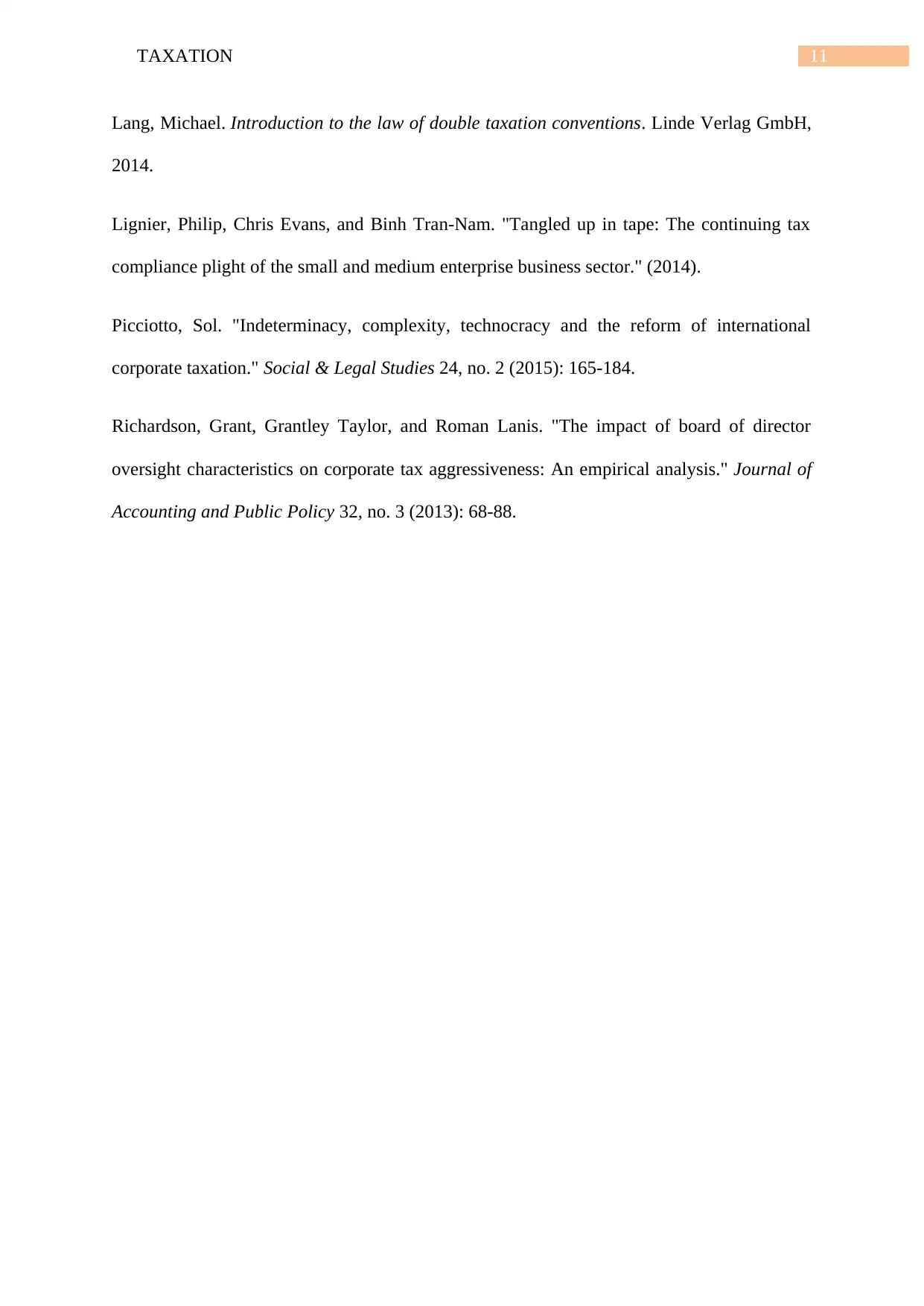
11TAXATION
Lang, Michael. Introduction to the law of double taxation conventions. Linde Verlag GmbH,
2014.
Lignier, Philip, Chris Evans, and Binh Tran-Nam. "Tangled up in tape: The continuing tax
compliance plight of the small and medium enterprise business sector." (2014).
Picciotto, Sol. "Indeterminacy, complexity, technocracy and the reform of international
corporate taxation." Social & Legal Studies 24, no. 2 (2015): 165-184.
Richardson, Grant, Grantley Taylor, and Roman Lanis. "The impact of board of director
oversight characteristics on corporate tax aggressiveness: An empirical analysis." Journal of
Accounting and Public Policy 32, no. 3 (2013): 68-88.
Lang, Michael. Introduction to the law of double taxation conventions. Linde Verlag GmbH,
2014.
Lignier, Philip, Chris Evans, and Binh Tran-Nam. "Tangled up in tape: The continuing tax
compliance plight of the small and medium enterprise business sector." (2014).
Picciotto, Sol. "Indeterminacy, complexity, technocracy and the reform of international
corporate taxation." Social & Legal Studies 24, no. 2 (2015): 165-184.
Richardson, Grant, Grantley Taylor, and Roman Lanis. "The impact of board of director
oversight characteristics on corporate tax aggressiveness: An empirical analysis." Journal of
Accounting and Public Policy 32, no. 3 (2013): 68-88.
⊘ This is a preview!⊘
Do you want full access?
Subscribe today to unlock all pages.

Trusted by 1+ million students worldwide
1 out of 12
Related Documents
Your All-in-One AI-Powered Toolkit for Academic Success.
+13062052269
info@desklib.com
Available 24*7 on WhatsApp / Email
![[object Object]](/_next/static/media/star-bottom.7253800d.svg)
Unlock your academic potential
Copyright © 2020–2025 A2Z Services. All Rights Reserved. Developed and managed by ZUCOL.





